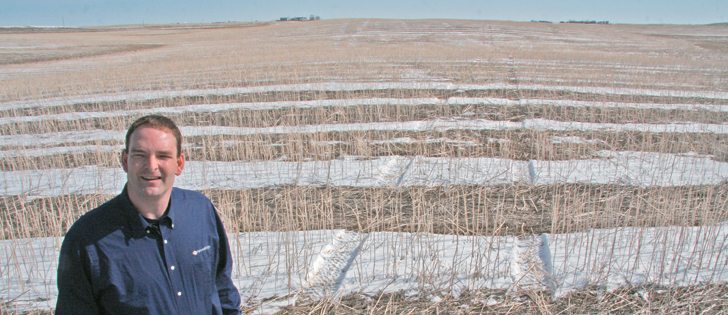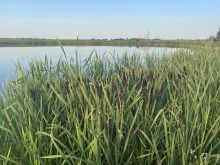Farmer’s Edge uses interior-mounted sampling equipment to take composite and precise soil sampling at any time of the year
It was a cold, dark night in February when Calvin Ruff found himself in a stubble field, face to face with an apprehensive farmer and the RCMP.
Ruff had been driving erratically around the field, and the light from his headlights had attracted the farmer’s attention, even though he didn’t own the field in question.
It soon became apparent that Ruff was taking soil samples for Farmer’s Edge, a precision agriculture company that helps farmers achieve maximum yields through fertility recommendations.
With its pick-up trucks equipped with small, interior-mounted hydraulic soil probes and global positioning systems, Farmer’s Edge personnel can take soil samples at any time of year and any time of day.
Read Also

Farm groups ask feds for export sales reporting
The Agricultural Producers Association of Saskatchewan and SaskCrops asks the federal government to create an Export Sales Reporting program.
“From somebody else’s perspective, you might be a bit of a hooligan,” said Ruff in describing the incident.
“What are you doing out there and why are you driving so erratic? Of course, when you’re doing this, you’re not driving in a straight line. You’re driving all over the field in every direction.”
Ruff took it in stride. The alert farmer had called the RCMP, and while waiting for officers to arrive and assess the situation, Ruff decided to do a little advertising.
“He cut me off on the way out of the field so I couldn’t get out, which was fine. I ended up having to talk to him for about 45 minutes, trying to sell him on our project.”
On this particular March day, Ruff is demonstrating how the sampling is done on a field studded with the mini-forest of canola stubble.
The new Ford truck, with a hole cut through its floorboards for the soil probe, stops to take a sample. Ruff scrapes away surface soil litter and activates the soil probe.
With a low whirring sound, it pushes into the soil, lifting the truck slightly as it punches through the frost layer. Sample obtained, the probe is extracted and Ruff puts a core from the first six inches in one bag and the core from six to 24 inches in another.
The bags will later be labelled and boxed to ensure accuracy.
The company offers composite sampling and more precise sampling so that it can provide variable rate fertilizer recommendations.
In both cases, it uses satellite imagery and field zone mapping to obtain either a field average or more precise information by zone.
In composite sampling, “we’re taking an average of your fields,” said Ruff.
“When we take an average of the field, we educate our samplers on where to pull the dirt from…. When you’re composite sampling, you don’t want to take from that low spot and you definitely don’t want to take it from the hilltops. You want the best average for the field. So if you take too many from high spots and low spots, you’ll skew your numbers.”
Composite sampling comprises soil from 16 points in the field, while precision sampling is 16 samples per zone. There can be six or seven zones, depending on what satellite imagery and ground truthing have revealed.
That is a lot of soil.
“Now you want low spots and high spots because you want to know why that zone is different,” said Ruff.
Core samples in this field south of Lethbridge show good soil moisture right down to the 24-inch depth, despite relatively little snowfall this winter and little current snow cover.
‘It melted right away, it didn’t blow away.”
He and his colleagues have tested 1,100 fields this winter in a region encompassing all of Alberta south of Calgary. That’s an area of about seven million acres.
“We have done a substantial amount,” he said. “We’re still trying to convince farmers that winter sampling is fine, rather than everybody coming for a rush sample just before seeding.”
Some farmers think spring soil testing will provide the most accurate results, but Ruff said research indicates fall sampling is just as good. Moisture levels are the main variable.
The soil samples are sent to the Farmer’s Edge lab in Winnipeg for analysis. The extent of the analysis depends on the package the farmer has purchased.
The information is used to provide fertility recommendations, and Ruff said having a dedicated lab is a major asset for both speed and consistency.
However, that consistency must begin here in the field, with accurate and representative samples.
“The east side of the hills can always be bad in our territory because you get the winds and you do get drifts,” he said.
“You’ll come over a hill and everything will be great, but suddenly there will be a four foot drift, so you have to be careful.”
He said it is rare for trucks to get stuck in fields. They don’t run if fields are too wet or the risk of rutting is too great, unless the farmer is in a hurry for the tests and gives the go-ahead.
Dale Steele, also of Farmer’s Edge, estimates that 20 percent of farmers take soil samples or pay to get it done, though some local agrologists think that number is low.
Ruff said he isn’t sure why more people don’t test their soil.
“From farmers I’ve talked to, the progressive ones really want to sample,” he said.
“But some of the farmers in the past, we’re talking 30 plus years ago, soil sampling was sold and it turned into a bit of snake oil, the reason being that people didn’t have a designated lab.”
He speculated that inconsistent results discouraged some farmers from sampling.
Ruff said soil analysis always shows something that can be added to the field for better potential yield, regardless of the field. Additional nitrogen is the most common requirement, but information is also provided for phosphorus, potassium, sulfur, organic matter and macro and micronutrients, depending on the package that is purchased.
He said the client would ideally buy a package for more than one year, giving the company time to show the effectiveness of its recommendations.
That may not always happen, but there are always plenty of soil samples to be taken.
The canola stubble makes a hissing, scraping sound against the bottom of the truck as it passes through the field, bouncing over the odd rock and hummock.
“This job is very hard on trucks, but it is what it is,” Ruff said.
“You drive the fields and they bounce a lot. And imagine doing this for a 10 hour day.”
Company policy forbids “barreling across the field,” and although soil samplers can do their work in the comfort of their truck cabs, it isn’t as easy as it looks.
“Forty km-h all day in a rough field can still pound the snot out of everything,” Ruff said.
Contact barb.glen@producer.com
















